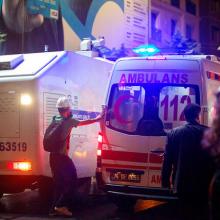troops
Of 1,131 active-duty service members, 30 percent surveyed that white nationalism poses a greater threat to U.S. national security than ISIS conflicts in Syria and Iraq, as additionally reported by Newsweek.

Image via Gregg Carlstrom/flickr.com
On Dec. 19 the Russian ambassador to Turkey Andrei Karlov was assassinated in Ankara, Turkey, reports Reuters. The ambassador was giving a speech at an art gallery when a gunman fatally shot him. Three other people were also wounded and the gunman appears to have been killed.
“Don’t forget Aleppo, don’t forget Syria!” the gunman shouted after the shooting.
As America began to gear up for its incredibly wasteful (more than $40 trillion since 1972) and utterly futile “War on Drugs,” there were three critical federal actions that contributed to our current vastly over-militarized police forces.
In 1981, the Military Cooperation with Law Enforcement Act was passed. This law authorized military collaboration with civilian law enforcement agencies and dramatically expanded the Army’s participation in counterdrug efforts and included arming and training of local police with military grade weapons, free of charge, at the discretion of the Secretary of Defense.
Then, in 1984, Congress passed the Comprehensive Crime Control Act, supposedly to assist in controlling the crack cocaine infusion in urban communities. This law, tied to a civil forfeiture provision, allows law enforcement to seize property without a conviction, or even charges being levied, if a person is suspected of illegal drug activity.
Finally, in the 1990 National Defense Authorization Act (each year this bill funds our military) there was included a provision — “Section 1208” — that allowed the Secretary of Defense to transfer weapons and ammunition that was “suitable for use by such agencies in counter-drug activities.” This law was supposed to give police the firepower needed to “effectively” execute the Drug War. In the 10 years that followed, thousands of tanks, helicopters, grenade launchers, and assault rifles were granted to municipal police forces.
But the militarization of our police forces was not yet complete.
Enter the “War on Terror.”
A fundamental principle [of ancient Greek tragedy], often overlooked, is that the double and the monster are one and the same being.
- René Girard, Violence and the Sacred (p. 160)
The debate about the use of drone strikes in the so-called “War on Terror ” has shed light on an inevitable calculus of war: how many civilian casualties can be tolerated in pursuit of our goals? President Barack Obama, in his speech on May 23 at National Defense University, referred to the drone strikes in Pakistan, Yemen, and Somalia, admitting, “It is a hard fact that U.S. strikes have resulted in civilian casualties, a risk that exists in all war.” But of course, our wars and our use of drones were conceived as a legitimate response to the civilian deaths on 9/11 and a defensive maneuver to prevent future attacks.
Obama Defends Drone Attacks
In his speech, Obama further justified the use of drones by stating it reduces the number of civilian casualties compared to boots-on-the-ground wars. Though the numbers are hard to determine, it has been reported by the Canadian Broadcasting Corporation that civilian casualties caused by our invasion of Iraq number somewhere between 55,000 and 60,000. In Afghanistan, from the time reporting began in 2007, the Guardian reports that the total number of civilians who have lost their lives in the armed conflict to be 14,728. For drone strikes, the highest estimates put total civilian deaths at around 950, indisputably a better number.
The Illogical Logic of Violence
Reducing the number of deaths caused by our use of violence is a worthy goal, and Obama does seem genuinely engaged in drawing the number down. So for the sake of argument, I will take him at his word. But (you knew there was a but coming!), he is trapped, as so many of us are, within the logic of violence.
Presidents Obama and Karzai have signed in Kabul a strategic partnership agreement between the two countries.
The Associated Press reports:
“The partnership spells out the U.S. relationship with Afghanistan beyond 2014, covering security, economics and governance. The deal is limited in scope and essentially gives both sides political cover: Afghanistan is guaranteed its sovereignty and promised it won't be abandoned, while the U.S. gets to end its combat mission in the long and unpopular war but keep a foothold in the country. The deal does not commit the United States to any specific troop presence or spending. But it does allow the U.S. to potentially keep troops in Afghanistan after the war ends…”
“At a signing ceremony in Kabul with Afghan President Karzai, Obama said the agreement paves the way for 'a future of peace’ while allowing the United States to ‘wind down this war.’ Karzai said his countrymen ‘will never forget’ the help of U.S. forces over the past decade.”
George Masters, combat veteran and freelance writer, writes of driving behind a car with two 'Support Our Troops' ribbons. In his head, he responds:
I’m driving angry. I want to tell the guy in front of me: You want to support the troops? Get them the hell out of the line of fire. Or, if you think this war is so necessary, get over there yourself. If you’re too old, pull your kids or grandkids out of college and send them.
I’m driving sad. You want to support our troops? Give the man some space when he gets home. Give the woman a jo
After a vivid and harrowing description of his 1968 combat tour in Vietnam, he ends:
You want to do something for our troops? Bring them home.


